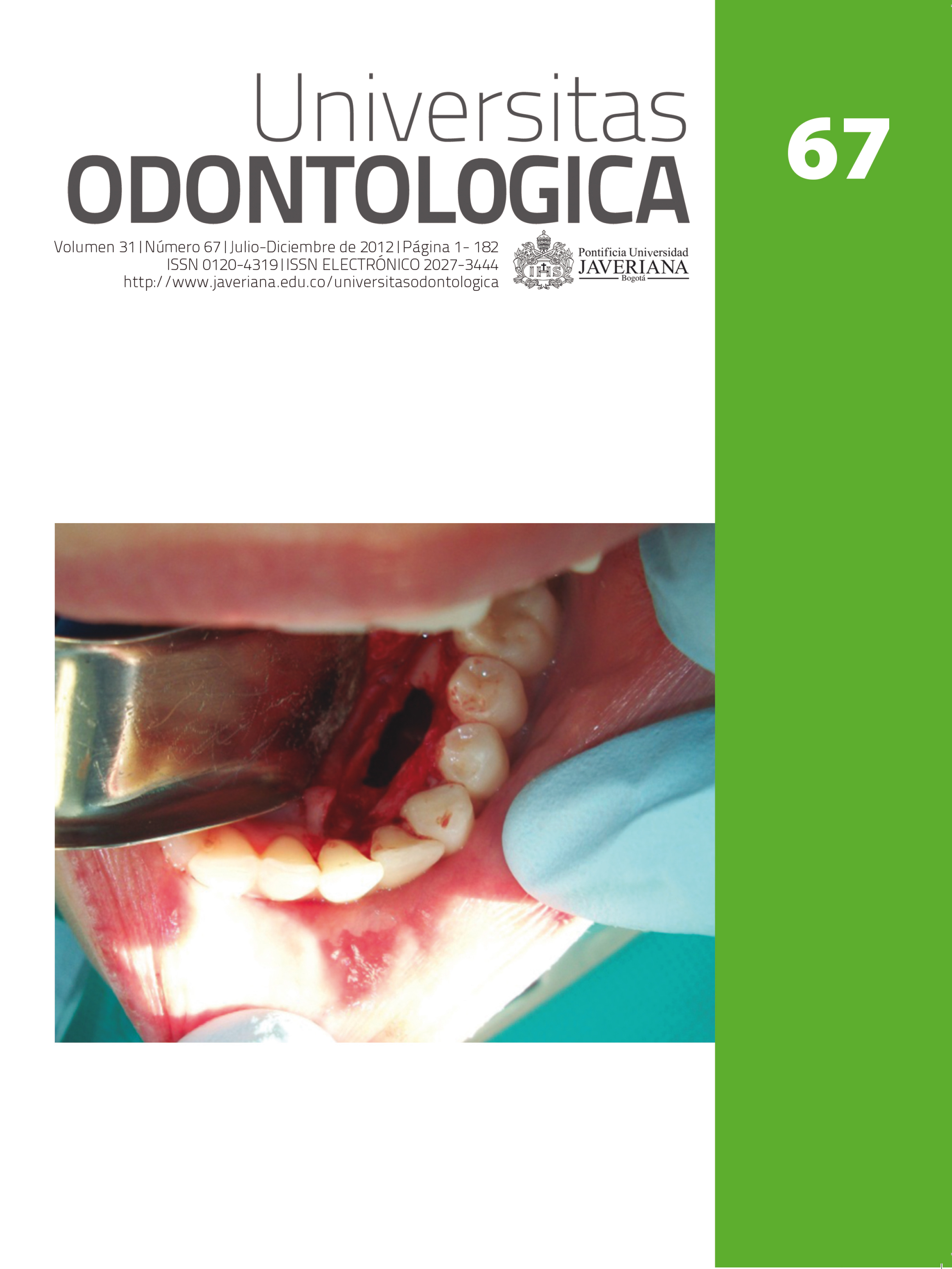Abstract
Antecedentes: La enfermedad periodontal (EP) es un factor de riesgo para desarrollar enfermedadescardiovasculares. Puede influir e iniciar una reacción autoinmune, aumentandola inflamación sistémica y acelerando la progresión de placas ateroescleróticas prexistentes.Ante inflamación aumenta la concentración de proteína C-reactiva (medida por PCR-us),que está relacionada con ateroesclerosis y riesgo cardiovascular. Se ha encontrado queel valor de PCR-us es significativamente mayor en pacientes con periodontitis. Objetivo:Determinar si existen diferencias significativas en los valores de PCR-us de pacientes conEP crónica entre moderada y avanzada no tratada y pacientes edéntulos totales comomarcador de ausencia de EP. Métodos: El diseño fue de casos y controles con una muestrade 60 pacientes mayores de 30 años de edad (30 casos con periodontitis crónica moderadaa avanzada y 30 controles edéntulos totales). Se tomó una muestra de sangre a todos lospacientes (cuadro hemático, colesterol, triglicéridos, glucemia, PCR-us) y se analizaron loshallazgos. Resultados: El promedio de PCR-us en los pacientes con periodontitis fue 2,19mg/L, y en los pacientes edéntulos, de 4,12 mg/L. Existe una tendencia a hallar valoresde PCR-us más elevados en pacientes edéntulos, al considerar que se encontró mayorexposición al riesgo en los pacientes con periodontitis. Los resultados no fueron estadísticamentesignificativos. Conclusión: La PCR-us se presentó más aumentada en los pacientesedéntulos totales y los valores de PCR-us en pacientes con periodontitis no se observaroncomo un factor de riesgo elevado para enfermedad cardiovascular.
Background: Periodontal disease (PD) is a risk factor for cardiovascular disease. It caninitiate an autoimmune reaction, increase systemic inflammation, and accelerate the progressionof preexisting atherosclerotic plaques. In presence of inflammation, PD increasesthe concentration of C-reactive protein (measured through hs-CRP) that is associated withatherosclerosis and cardiovascular risk. It has been found that the value of hs-CRP is significantlyhigher in patients with periodontitis. Objective: Determine if there are significantdifferences in the values of hs-CRP among patients with untreated moderate-to-advancedchronic PD and edentulous patients (marker of absence of PE). Methods: A case-controlstudy was carried out with a sample of 60 patients older than 30 years of age (30 cases withmoderate-to-advanced chronic periodontitis diagnosed and 30 edentulous controls). Bloodsamples were taken from all patients (complete blood count, cholesterol, triglycerides, glucose,hs-CRP) and the results were compared. Results: The average hs-CRP in patients withperiodontitis was 2.19 mg/L and 4.12 mg/L in edentulous patients. There is a tendency tofind values higher of hs-CRP in edentulous patients, given that there was higher exposure inpatients with periodontitis. The results were not statistically significant. Conclusion: hs-CRPwas higher in edentulous patients and hs-CRP values in patients with periodontitis were notseen as a high risk factor for cardiovascular disease.
This journal is registered under a Creative Commons Attribution 4.0 International Public License. Thus, this work may be reproduced, distributed, and publicly shared in digital format, as long as the names of the authors and Pontificia Universidad Javeriana are acknowledged. Others are allowed to quote, adapt, transform, auto-archive, republish, and create based on this material, for any purpose (even commercial ones), provided the authorship is duly acknowledged, a link to the original work is provided, and it is specified if changes have been made. Pontificia Universidad Javeriana does not hold the rights of published works and the authors are solely responsible for the contents of their works; they keep the moral, intellectual, privacy, and publicity rights.
Approving the intervention of the work (review, copy-editing, translation, layout) and the following outreach, are granted through an use license and not through an assignment of rights. This means the journal and Pontificia Universidad Javeriana cannot be held responsible for any ethical malpractice by the authors. As a consequence of the protection granted by the use license, the journal is not required to publish recantations or modify information already published, unless the errata stems from the editorial management process. Publishing contents in this journal does not generate royalties for contributors.


